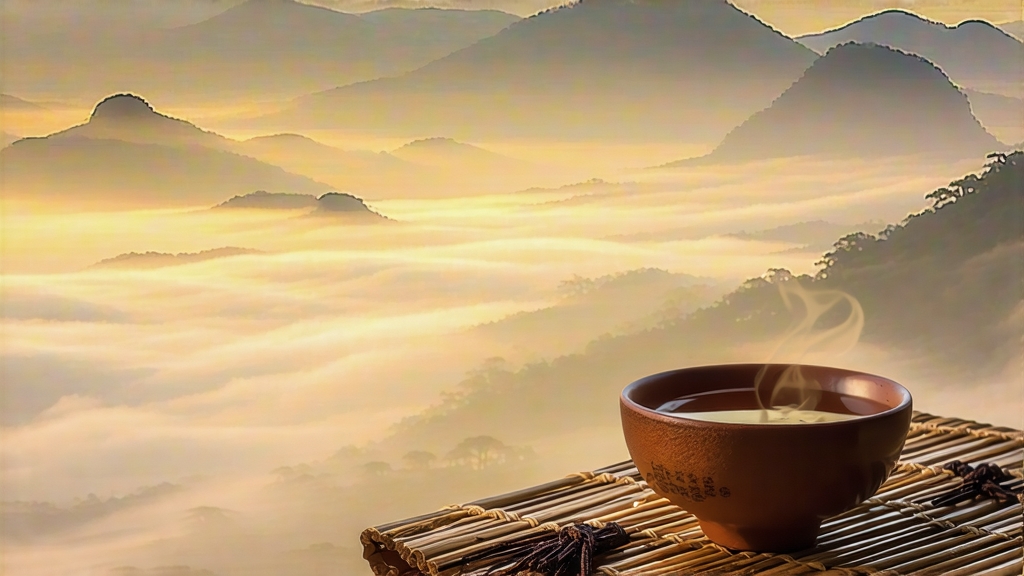
Tucked high above the Sichuan basin where perpetual cloud drifts between emerald ridges, Meng Ding Huang Ya has been quietly mastering the art of “yellowing” for almost two millennia. International drinkers often greet yellow tea as China’s rarest color-category, yet within that niche Meng Ding Huang Ya is the whispered legend: an imperial tribute during the Tang dynasty, a scholarly indulgence in Song teahouses, and today a living relic produced in batches smaller than most single-estate Darjeelings. To understand it is to witness time, moisture and human patience being folded into one perfect bud.
History: from altar to emperor
Buddhist monks planted the first tea gardens on Meng Ding (“Meng Summit”) around 53 BCE, allegedly to keep awake during all-night sutra recitations. By 742 CE the region’s tiny golden buds were freighted down the Min River to Chang’an, freighted with temple incense still clinging to the bamboo cases. Tang chronicles record Emperor Xuanzong reserving the first spring pick for ancestral rites, believing the tea’s golden liquor symbolized the dynasty’s mandate of heaven. The Song court refined the etiquette: tribute lots were carried in silk-lined porcelain jars sealed with wax and imperial ciphers; any leaf that arrived broken was rejected, ensuring only intact buds—still today the hallmark of Meng Ding Huang Ya—graced the palace. After the 17th-century turmoil of Ming-Qing transition the tea vanished from court records, surviving only in monastic micro-gardens. Rediscovered by tea engineers in 1959, it was re-established as one of China’s Ten Famous Teas, yet annual yield hovers below 3 000 kg, making each gram a sip of restituted history.
Micro-terroir: why the mountain makes yellow
Meng Ding sits at 29.9 °N, 1 450 m above sea level, squarely in the transition zone between Sichuan’s subtropical basin and the Himalayan rain shadow. Morning fogs condense on ancient ginkgo and wild camellia, dripping back onto sandy loam rich in selenium and zinc. Diurnal swings of 12 °C slow amino-acid metabolism, concentrating the sweet compound theanine while keeping catechins moderate—ideal for the mellow profile yellowing seeks. Indigenous cultivar “Meng Ding Xiao Ye Zhong” (small-leaf Meng stock) has pubescent young buds whose down traps moisture, a natural aid to the controlled re-fermentation that follows.
Plucking: one bud, no leaf, no rain
The picking window opens when the mountain azalea blooms—usually 20 March to 5 April—signaling soil temperature has reached 10 °C. Only buds 12–18 mm long, still sheathed in pale green scales and carrying the silvery “hawk’s claw” down, qualify. Experienced pickers pinch sideways so the bud snaps cleanly; any torn surface would oxidize unevenly later. A full day’s work yields barely 500 g fresh weight, which shrinks to 100 g after the long yellowing protocol.
Craft: the sealed yellowing ritual
Unlike green tea’s instant kill-green, Meng Ding Huang Ya undergoes a three-stage “men huang” (sealed yellowing) that can last 72 hours.
- Sha Qing (kill-green): buds are tumble-roasted for 3–4 min at 140 °C on a Meng Ding bronze wok curved like a crescent moon. The aim is 65 % moisture reduction, just enough to denature polyphenol oxidase while leaving inner cells pliable.
- Re Hong (re-bake): temperature drops to 80 °C; workers roll the buds lightly in palm-bamboo trays to coax residual moisture to the surface. When buds feel velvet and emit a faint popcorn note they are ready for the critical step.
- Men Huang (sealed yellowing): the hot buds are piled 8 cm deep inside linen bags, then slid into a pine-wood cabinet lined with wet rice paper. The cabinet door is latched; humidity hovers at 85 %, temperature 32 °C. Over the next 48 hours a gentle re-fermentation occurs: chlorophyll degrades into pheophytin, catechins dimerize, and a golden-yellow pigment forms. Every 6 hours the pile is fluffed to prevent anaerobic souring; masters judge readiness by aroma—when the green grass